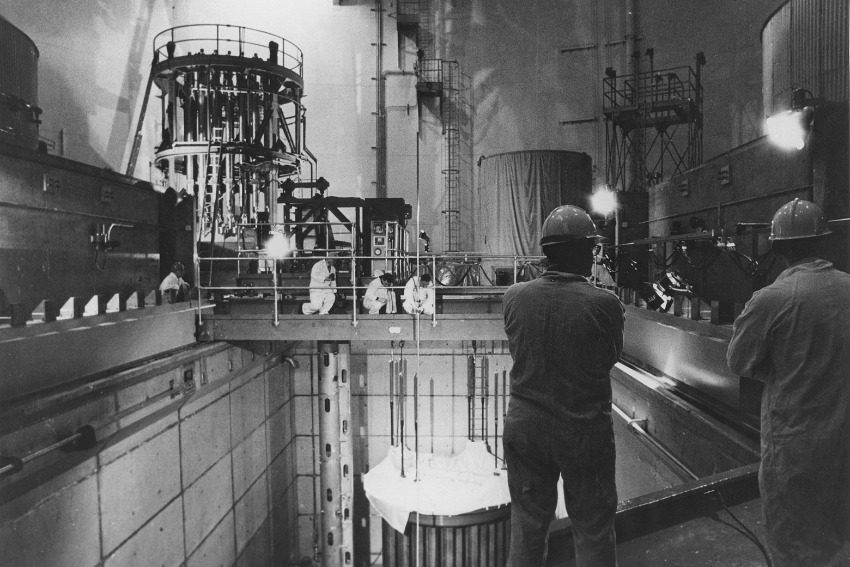
Workers load the first fuel at the Palisades in 1974. (Smith Collection/Gado/Getty Images)
Federal investments from the Biden-Harris administration will help restart a shuttered power plant, generate cleaner energy in southwest Michigan, and save thousands of jobs.
MICHIGAN—The state could soon be home to the only nuclear power plant in the country to have shuttered and then reopened after the federal officials this week finalized more than $2.8 billion in loans and grants to help restore and restart the Palisades Plant in southwest Michigan.
“Reopening Palisades will keep energy costs low, shore up domestic energy production, and secure Michigan’s competitiveness for future economic development,” Gov. Gretchen Whitmer said in a statement. “We will lead and build the future here in Michigan with the strongest clean energy labor standards in the nation, and tools to build more renewable energy faster.”
In March, the Biden-Harris administration announced that it would provide a $1.52 billion loan through the Inflation Reduction Act’s Infrastructure Reinvestment Program to help restart the nuclear power plant in Covert, which was shut down in 2022 and sold to Holtec International.
That deal with the US Department of Energy—along with about $1.3 billion in grants provided through the US Department of Agriculture and Rural Development—was finalized last week. And now officials are seeking to get the nuclear plant back into operation as soon as possible.
“Michigan needs more clean energy production to meet our decarbonization goals,” state Rep. Joey Andrews (D-St. Joseph) said in a statement. “I am proud to see Southwest Michigan lead the nation as the first to restart a nuclear power plant with the reopening of Palisades. This historic achievement ensures we are advancing our economy, providing Michiganders with high-paying job opportunities and making strides toward our clean energy goals.”
Whitmer said the investments from the Biden-Harris administration will also help protect 600 union jobs at the nuclear plant, as well as at least 1,100 other jobs within the local community, while also bolstering access to clean, reliable electricity for about 800,000 homes in the region.
About half the jobs at the plant are expected to be union jobs, with Holtec locking down project labor agreements with at least 15 trade unions that are supporting the project, officials said.
A 2023 study from the University of Michigan found reopening the plant would boost the local economy by adding $90 million in gross personal income for local residents each year, and lead to about $40 million in extra annual tax revenue for the state and local community.
Nuclear energy also produces far less greenhouse gas emissions than fossil-fuel based electricity plants—and carbon emissions are the largest contributor to global climate change.
“It’s a powerful clean energy comeback story that represents a chance to build our manufacturing capacity and rebuild our middle class,” White House National Climate Advisor Ali Zaidi said in a statement. “This is the playbook for how Michigan, and America, wins the future.”
What’s Palisades?
Palisades is a nuclear plant along Lake Michigan, about a one-hour drive from Kalamazoo, that employed 600 workers while it was in operation. In 2022, workers there reportedly made an average salary of $118,000. The plant also supported over 1,100 other jobs in the area, and produced enough clean electricity (about 800 megawatts) to power about 800,000 homes.
A Michigan utility, CMS Energy, owned the plant from 1971 until it was sold to Louisiana-based utility Entergy in 2007. It was decommissioned in May 2022. And about one month later, it was sold to Holtec International, which, at the time, had initial plans to dismantle the site.
What’s happening?
With loans made available through the Inflation Reduction Act’s Infrastructure Reinvestment program, as well as another $300 million earmarked for the project in this year’s state budget, the plant is now set to be brought back online to keep producing power through at least 2051.
This week, the USDA also awarded more than $1.3 billion in grant funding (through the Empowering Rural America program) to two rural electric cooperatives, Wolverine Power Cooperative and Hoosier Energy—namely to finance the purchase of electricity from Palisades, with the goal of passing the savings on to customers in Michigan, Illinois, and Indiana.
Officials said those investments will ultimately help lower energy costs for rural communities in Michigan. And as non-profit wholesale electric suppliers that are owned by their customers, both Wolverine and Hoosier must pass 100% of the savings directly to local homes and businesses.
“President Biden and Vice President Harris have been clear that rural electric cooperatives are the backbone of our nation and investing in them is a top priority,” US Agriculture Secretary Tom Vilsack said in a statement announcing the funding. “We can continue supporting a more prosperous future for rural communities by accelerating the transition to clean energy, keeping monthly bills low for American families and investing in a strong rural workforce.”
Hoosier is receiving more than $675 million, which is expected to create nearly 800 jobs, as well as provide an annual estimated cost savings of $35 million to Hoosier Energy members. Wolverine is receiving more than $650 million, which will put the cooperative (and rural communities across Michigan) on track to reach 100% carbon-free energy before 2030.
How did we get here?
Federal officials said the investments mark a first-of-its-kind effort by the federal government to restart an American nuclear power plant—all with the aim of generating cleaner energy, saving and expanding a local union workforce, and strengthening the US nuclear energy sector.
The restart of the plant will also help advance climate and domestic energy goals that have been set by the Biden-Harris administration, including the Justice40 Initiative, which calls for 40% of federal investments to flow to marginalized, under-resourced, or polluted communities.
“Nuclear power is America’s largest source of carbon-free electricity, supporting hundreds of thousands of direct and indirect jobs across the country and will play a critical role in tackling the climate crisis and protecting public health and the environment from its impacts,” US Energy Secretary Jennifer Granholm said in a statement. “Under President Biden and Vice President Harris’ leadership, the [US Department of Energy] and our partners across the federal government are working around the clock to ensure this vital source of clean electricity—and the vibrant workforce it supports—continues to power our nation for generations to come.”
The Biden-Harris administration’s Inflation Reduction Act marked the largest single investment in climate and clean energy in American history. So far, the legislation has spurred at least 62 new clean energy projects in Michigan, including to support automotive manufacturing projects.
Reports show those projects have also led to more than $26 billion in investment statewide, leading to the announcement of more than 21,000 new jobs for Michiganders—and counting.
What’s next?
The exact timeline for bringing Palisades back online is fluid. The project faces some hurdles, including inspections, testing, and the blessing of the US Nuclear Regulatory Commission.
In a statement, officials at Holtec said they’ll stay committed to keeping the general public (and other interested stakeholders in the area) informed of site activities as the project continues.
“This is a triumph for the United States in our collective pursuit of a clean and dependable energy future,” Holtec President Kelly Trice said in a statement this week. “The repowering of Palisades will restore safe, around-the-clock generation to hundreds of thousands of households, businesses, and manufacturers. It also confers the environmental and public health benefits of emissions-free generation, hundreds of high-paying local jobs with a large union workforce, economic growth, and the social benefits of a strong community partner.”
The Associated Press contributed to this report.
READ MORE: Federal investments put union workers at heart of clean energy boom
For the latest Michigan news, follow The ‘Gander on Twitter.
Follow Political Correspondent Kyle Kaminski here.
Support Our Cause
Thank you for taking the time to read our work. Before you go, we hope you'll consider supporting our values-driven journalism, which has always strived to make clear what's really at stake for Michiganders and our future.
Since day one, our goal here at The 'Gander has always been to empower people across the state with fact-based news and information. We believe that when people are armed with knowledge about what's happening in their local, state, and federal governments—including who is working on their behalf and who is actively trying to block efforts aimed at improving the daily lives of Michigan families—they will be inspired to become civically engaged.


New passenger train route between Holland and Detroit to be explored
LANSING – The Michigan Department of Transportation is developing a plan to potentially construct the state’s fourth passenger rail route. The...

Ann Arbor residents plan ballot initiative to dump DTE and shift city toward public power
BY KYLE DAVIDSON, MICHIGAN ADVANCE MICHIGAN—A group of Ann Arbor residents are taking the first steps toward removing DTE Energy as their electrical...

Scholten leads Michigan Dems calling on Trump administration to restore solar energy funding
BY KYLE DAVIDSON, MICHIGAN ADVANCE MICHIGAN—Following the Environmental Protection Agency’s decision to cancel funding for the federal Solar For All...

Michigan asking residents to list investment priorities for Belle Isle state park in Detroit River
By: DUSTIN BLITCHOK/Planet Detroit DETROIT (AP)—More than a decade after the state of Michigan took over management of Belle Isle, residents are...

Flint, Michigan’s journey to clean water: What you need to know
The EPA has lifted an emergency order on Flint's water system after 8 years of compliance with federal lead standards and $100M in infrastructure...





